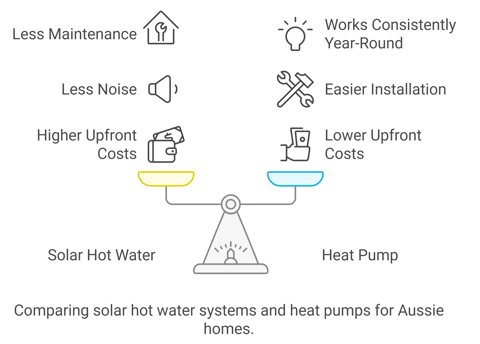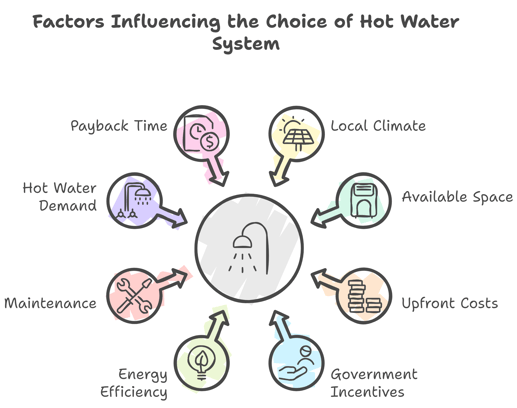Save Money: Solar Hot Water Price vs Heat Pump for Aussie Homes
Comparing installation and running costs between solar hot water and heat pump systems for australian homes. Which system yields the best return on investment?
Yann Guihard and Rainer Schütz Sauer
10/8/20249 min read
G'day, Aussie homeowners! Are you ready to give your wallet a break and Mother Nature a high-five? The solar hot water price debate is heating up, and it's time to dive into the sizzling showdown between solar hot water systems and heat pumps. These eco-friendly dynamos are transforming how we warm our showers and wash our dishes, promising energy savings that'll make your electricity bill do a happy dance.
So, what's the go with these green machines? We're about to take you on a ripper of a journey through the basics of solar hot water and heat pump systems. We'll chat about upfront costs, government incentives that'll make your bank account smile, and the nitty-gritty of energy efficiency. By the end, you'll be equipped to choose the best system for your home, weighing up factors like maintenance, hot water demand, and payback time. Let's get cracking and make those Aussie homes greener!
The Basics of Solar Hot Water and Heat Pump Systems
Solar Hot Water Technology
Solar hot water systems harness the sun's energy to heat water for household use. These systems typically consist of solar collector panels and a storage tank. For a family of four, about four square meters of solar panels and a 300 to 360-litre tank are usually sufficient. The solar collectors, often mounted on the roof, absorb sunlight and transfer the heat to water circulating through pipes. This heated water then flows into an insulated storage tank, ready for use.
There are two main types of solar hot water systems: active and passive. Active systems use pumps to circulate water, while passive systems rely on natural convection. In regions like Perth, Brisbane and the Northern parts of Australia, where sunshine is abundant, solar hot water systems can significantly reduce energy bills and carbon footprints.
Heat Pump Technology
Heat pump hot water systems work differently from solar hot water systems but are equally energy-efficient. These systems operate like a refrigerator in reverse, extracting heat from the surrounding air and transferring it to heat water in a storage tank. This process makes heat pumps three to five times more energy-efficient than conventional electric resistance water heaters.
Heat pumps can function effectively even in cooler temperatures, typically between 4°C to 33°C though some models work in even lower temperatures. They require at least 28 cubic meters of air space around the unit for optimal performance (a space of about 3 x 3 x 3 meters). Unlike solar hot water systems, heat pumps can operate day and night, regardless of weather conditions.
Key Differences
The main difference between solar hot water and heat pump systems lies in their energy source. Solar systems directly use the sun's radiation, while heat pumps extract heat from the ambient air. This distinction affects their performance in various climates and seasons.
Solar hot water systems may require a backup heating source for cloudy days or high hot water demand periods - either a gas or electric booster. Heat pumps, on the other hand, can operate consistently year-round but consume some electricity to transfer heat.
Both systems offer significant energy savings compared to traditional water heaters. The choice between them often depends on factors such as climate, available space, and personal preferences. Regardless of the choice, both options contribute to reducing household energy consumption and promoting a greener lifestyle.


Upfront Costs and Government Incentives
Solar Hot Water Pricing
When it comes to solar hot water price, Aussie homeowners might experience a bit of sticker shock at first. These systems typically cost between A$4,500 and A$9,000 fully installed. The price tag varies depending on the type and size of system you choose. Flat plate collectors are usually the most budget-friendly option, ranging from A$4,500 to A$6,000. If you're after top-notch efficiency, evacuated tube collectors might be more expensive, starting at A$7,000.
Heat Pump Pricing
Heat pump hot water systems, on the other hand, are often easier on the wallet upfront. You can expect to shell out around A$4,500 for a good quality heat pump system, even though top-of-the range options may be dearer. However some models may start as low as A$3,000 fully installed.
Available Rebates and Incentives
Now, here's where things get interesting for budget-conscious Aussies. The government's keen on helping you make your home greener, so they've cooked up some sweet deals to offset those upfront costs. The Small-scale Renewable Energy Scheme is a ripper of a program that can save you a bundle. It works by issuing Small-scale Technology Certificates (STCs) for your new system. These little beauties can be traded for cash or a discount on your purchase price. Depending on what system you install and where you live the rebate could be up to A$1,000. You won’t need to do anything, your installer will take care of all the administrative nitty-gritty and automatically apply the discount.
But wait, there's more! Some states are doubling down on the savings. In Victoria, for example, eligible households can score an extra A$1,000 rebate through the Solar Homes Program. New South Wales isn't far behind, offering rebates of up to A$600 on both heat pump and solar systems through their Energy Savings Scheme.
Energy Efficiency and Environmental Impact
Solar Hot Water Efficiency
For a typical Aussie family of four, 20% to 40% of home energy usage goes to heating water. This can represent annual costs of up to A$1,000 when using traditional electric or gas hot water systems.
Solar hot water systems are highly efficient, converting sunlight into heat for free without using any other source of energy. Except when water needs to be heated outside of sunny hours, when an electric or gas booster is used. This still translates to significant energy savings and a reduced carbon footprint, overall using up to 75% less energy than traditional systems. This makes them a sustainable and cost-effective option for many households, who would typically save A$500 to A$750 per year in energy bills. This can pay back the upfront investment in about 10 years.
Heat Pump Efficiency
Heat pump hot water systems are also incredibly efficient, using electricity to transfer heat from the surrounding air to the water instead of directly heating the water. These systems can achieve an average efficiency of around 400%, which means each kilowatt of electricity provides 4 kilowatts of heat. This is significantly higher than traditional electric water heaters that typically have an efficiency of around 90-95%.
This high efficiency means heat pumps can save up to 75% on energy compared to conventional systems, similar to solar hot water systems. They can also prevent about 1.0 to 2.5 tons of greenhouse gas emissions each year. They allow households to save A$500 to A$750 annually in energy bills, generally paying back the initial investment in 5 to 7 years.
Conclusion: Choosing the Best System for Your Needs
To wrap up, both solar hot water and heat pump systems offer significant advantages for Aussie homeowners looking to save money and reduce their environmental impact. These eco-friendly solutions not only enhance your home’s energy efficiency but also pave the way for substantial savings on your utility bills over time. The choice between them really boils down to a few key factors, such as your local climate, the space you have available, and your specific hot water needs.
In the end, whether you opt for a solar hot water system or a heat pump, you're making a savvy decision that contributes to a greener home and lower energy costs. Solar hot water systems excel in sunny areas, providing nearly emissions-free heating and harnessing the sun's power to maximize savings. Meanwhile, heat pumps deliver consistent performance, even in cooler temperatures, and can operate around the clock regardless of the weather, offering reliability and efficiency.
Choose a solar hot water system if:
You are in a sunny area
You have a roof with available unshaded space and good sun exposure
You don’t want the system to make any noise
You don’t mind spending more upfront for a system that may last longer


In all other situations, a heat pump would probably be a better choice.
Don’t forget to take advantage of government incentives and rebates designed to offset the initial costs, making these eco-friendly options even more appealing. By carefully weighing the pros and cons of each system and considering your unique circumstances, you can make an informed choice that aligns with both your budget and environmental values. Ultimately, investing in renewable energy solutions is a win-win for your wallet and the planet, ensuring a sustainable future for generations to come.


FAQ - Frequently asked questions
1. What are the key differences between solar hot water systems and heat pumps?
The main difference between solar hot water systems and heat pumps lies in their energy source. Solar systems rely on the sun to heat water, making them more efficient in sunny regions. Heat pumps extract heat from the air and work efficiently across various climates, even at night or on cloudy days. While both systems reduce energy consumption and lower electricity bills, solar hot water systems may require a backup for cloudy periods, whereas heat pumps can operate consistently year-round but rely on electricity to function.
2. Which system is more energy-efficient for Australian climates: solar hot water or heat pumps?
Heat pumps are generally more energy-efficient and cost-effective across most Australian climates, especially in cooler areas. They use less electricity than traditional water heaters by extracting heat from the air. However, solar hot water systems are highly efficient in sunny regions like Queensland and Western Australia, where they can harness abundant sunlight to power your hot water needs.
3. How much can I save on energy bills and what is the payback period for solar hot water and heat pump systems?
The payback period for solar hot water systems is typically 8 to 10 years, while heat pump systems generally take about 5 to 7 years. Both systems can reduce water heating costs by up to 75% compared to traditional electric heaters, leading to substantial savings of A$500 to A$750 on energy bills.
4. What are the upfront costs of solar hot water systems vs heat pumps?
Solar hot water systems typically cost between A$4,500 to A$9,000 for a fully installed setup, depending on the type and size. Heat pumps tend to have lower upfront costs, ranging from A$3,000 to A$6,000. Keep in mind that both options are eligible for rebates that can significantly reduce these costs.
5. What government rebates and incentives are available for solar hot water or heat pump installations in Australia?
In Australia, several government rebates and incentive programs can help offset the costs of installing solar hot water or heat pump systems. The Small-scale Renewable Energy Scheme offers Small-scale Technology Certificates (STCs), which can be traded for a discount of up to A$1,000 on your system. In states like Victoria, you may be eligible for additional rebates of up to A$1,000 under the Solar Homes Program, while New South Wales offers up to A$600 through its Energy Savings Scheme. Always check with your state or territory government for the latest rebate offers.
6. Can heat pumps work effectively in cold Australian climates?
Yes, modern heat pumps are designed to work efficiently even in colder Australian climates, with some models still functioning effectively at sub-zero temperatures. However, their efficiency can decrease slightly in colder conditions compared to warmer environments. Advanced heat pumps can still provide reliable hot water in regions like Tasmania or the Blue Mountains.
7. Can I install a solar hot water system or heat pump in a small home?
Yes, both solar hot water systems and heat pumps can be installed in small homes, though you may need to consider space limitations. Solar systems require adequate roof space for the panels, while heat pumps need the equivalent of 3 x 3 x 3 meters of air space around the unit for optimal performance. Compact designs are available for smaller homes, so it’s worth discussing options with your installer.
8. What are the long-term maintenance requirements for solar hot water systems?
Solar hot water systems require periodic maintenance to ensure long-term efficiency. This includes cleaning the solar panels every 2-5 years to maintain optimal sunlight absorption. It’s also essential to check for potential leaks, inspect valves, and ensure the storage tank remains in good condition. Regular inspections from a certified technician every 5 years will help keep your system running smoothly.
9. What are the environmental benefits of using solar hot water and heat pumps?
Both solar hot water and heat pumps offer substantial environmental benefits by reducing your carbon footprint. Solar hot water systems are nearly emissions-free, preventing around 1 to 2.5 tons of greenhouse gas emissions annually. Heat pumps also have a positive impact, reducing CO2 emissions by about 1 ton per year compared to standard electric systems, and up to 2.5 tons when powered by renewable energy.


YOUR HOME ENERGY PARTNER
© 2024 Alpaca Solutions. All Rights Reserved. | Privacy Policy | Cookie Policy | Terms & Conditions
REQUEST A CALL BACK
Fill in your details and one of our experts will call you back.
Alpaca Solutions orchestrates the energy efficiency upgrades for your home and is your single point of contact from initial assessment to completion of works.
We are based in Sydney and are able to deliver projects Australia-wide.
